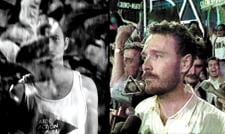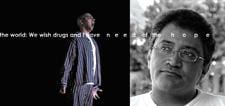
LIVE oN/No EVIL. Through a bewitching amalgam of opera, documentary and fiction, John Greyson's Fig Trees tells two stories of AIDS activism that reflect each other, one centred on Canadian Tim McCaskell (above right), the other on Zachie Achmat.
One of the defining characteristics of John Greyson’s work — whether art videos, installations, short films or features — is the way his ideas develop within each piece. Some people take their entire career to expound on a single thought. In Greyson’s oeuvre the metaphors and the references come fast and furious, growing exponentially from a thought or an utterance. Watching his work is like watching the spread of a tree in time-lapse: a stalk quickly turns into a trunk, and branches shoot out upon branches until the sky is dense with foliage.
His latest opus is no exception. The feature film/opera/documentary Fig Trees, conceived with composer David Wall, receives its North American premiere at Hot Docs. Originally a vast interactive installation exhibited at the Oakville Galleries in 2003/’04, in its new incarnation as a film, Fig Trees concerns the parallel tales of South African activist Zackie Achmat and local writer, educator and activist Tim McCaskell. This is a history of AIDS activism like you’ve never seen before. Fig Trees just won the Teddy (Greyson’s third) at the Berlin Film Festival for best queer documentary.
“It’s all Gertrude Stein’s fault,” jokes Greyson of the project’s origins. He and Wall share a mutual love of Stein and Virgil Thompson’s opera Four Saints in Three Acts. This affection for Stein, and where to channel it, was percolating while Greyson stayed with Achmat in South Africa shooting his last feature, the historical drama Proteus. That was when Achmat became a worldwide media sensation: From 1999 to 2003 the HIV-positive Achmat publicly refused drug treatments to protest the lack of access to expensive antiretrovirals for all but the richest South Africans.
“We had this kitchen table moment at one point, where he was being featured in a profile in the New York Times,” says Greyson, “and we were teasing him about it, saying, ‘Watch out, they’re going to start calling you St Zackie, and before you know it someone’s going to write an opera about you.’ And I thought, ‘That’s a pretty good idea.’ So those were the elements: Gertrude first, and Zackie second, and that collision of taking two things which should never be brought together and forcing them together and seeing what happens.”
The film is markedly different from the original installation piece. “The biggest change was deciding to make it tell two stories,” says Greyson. “One, the story of Zackie, which was in the original Oakville installation, and the other, the story of Tim and the story of AIDS Action Now. And so we became interested in telling the story of two pandemics: one North American, with the focus of the activist response being in the ’80s and ’90s, and then with Zackie’s story, the focus being the last decade.”
That is a very general summary. Consider how the opening moments of the film unfold and expand in Greysonesque fashion: A fictional Thompson and Stein, having finished Four Saints in Three Acts, are scouting for new inspiration and come across Zackie Achmat of the Treatment Action Campaign (TAC) on a drug strike. He refuses to take his AIDS medication until it is made affordable and available to all South Africans. Thompson and Stein want to turn him into St Zackie, which recalls St Zacharias, the founder of the eight-note musical scale, which in turn leads to a meditation on musical harmony, which leads to the palindrome, one of the major leitmotifs of the opera which, in turn, introduces us to McCaskell, whose story (told largely in documentary-style interviews) is constructed as a palindrome to Achmat’s (two stories that mirror each other). Achmat is on a drug strike; McCaskell is on a lachrymal strike — he will not cry, he refuses the melodrama of the AIDS pandemic.
The writer in Greyson is too impish to fall prey to swooning portentousness, and lightens the load of Fig Trees with surprising riffs and asides. For instance the film is narrated by St Martin, incarnated as a Trinity Bellwoods Park albino squirrel, and the black St Peregrine, incarnated as the street musician who plays the corner of Dundas and Spadina. Alexander Chapman, who starred in Greyson’s 1996 film Lilies, appears throughout in various tableaux, from a hospital ward to mock music videos.
That idea of refusing melodrama is central to Fig Trees, even though the narrative is told in the most melodramatic medium possible, opera.
But Wall and Greyson have larger strategies. “One of our first convictions was using Gertrude [Stein] as a means of turning the tragic opera inside out: refuse martyrdom, refuse tragedy, refuse sainthood.
“Zackie’s treatment strike and that larger refusal of opera gave us the spine for the story.” In formal terms, the opera of Fig Trees is interrupted by the documentary interview portions with Achmat and McCaskell.
In narrative terms, Greyson and Wall (who also sings the part of the fictional McCaskell) interrupt opera’s grandiose melodrama by honouring their subjects’ political and ethical unease with tragedy and martyrdom. The two activists embrace Greyson’s documentary rather than his opera. In real life, as the TAC gained immense political and social victories, Achmat ended his drug strike; in Fig Trees, the fictional Achmat (sung by Van Abrahams) does the same, snubbing the title of St Zackie. (And what good is an opera without an honest-to-goodness martyr?) Choosing life also affirms Greyson and Wall’s political stance.
“I think the martyr tradition exists in most cultures, maybe most obviously in Muslim cultures right now, but equally in Catholicism to this day,” says Greyson, “and if Gertrude’s talking about saints then I wanted to up the ante and talk about martyrs and a refusal of martyrdom and why it’s important for everyone to refuse martyrdom. Why martyrdom is in political terms, social terms and aesthetic terms ultimately self-indulgent, ultimately self-serving and ultimately reactionary in the broadest sense.”
“One of the things the film tries to track,” Greyson adds, “is how activists as leaders get forced into narratives that they don’t want. And so Fig Trees tries to track why those heroic, operatic, tragic narratives have great legs, but ultimately neither serve their subjects, nor any of us, and how we’ve got to find new ways of telling operatic narratives that refuse tragedies that are tied to martyrdom.”
Opera, documentary, Gertrude Stein, Virgil Thompson, Zackie Achmat, Tim McCaskell, harmonic theory, palindromic structure, AIDS activism, martyrdom, fictional truths: This is a heady 100-minute film. Some of this might pass you by but none of it will bog you down. Watching Greyson’s wildly expansive mind in action is never tedious nor overly theoretical. If we’re in the metaphorical realm of music, I would align it to a less grandiose form than opera — it’s much more akin to the improvisatory nature of jazz.
Underneath the fun, the excitement, the new melodies rushing by, is a masterful sense of discipline. When it’s done well — and in Fig Trees, it’s exemplary — the mastery is never pedantic, only playful, only delightful, only brilliant, and in the case of Fig Trees, with its lessons of activism and social ethics and aesthetic engagement, urgent, necessary and profound.

 Why you can trust Xtra
Why you can trust Xtra


